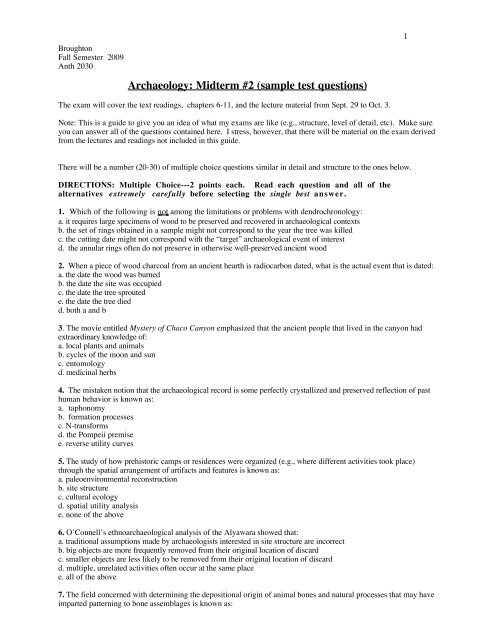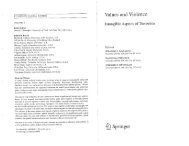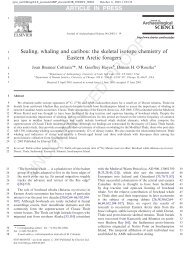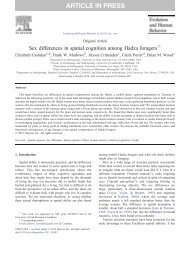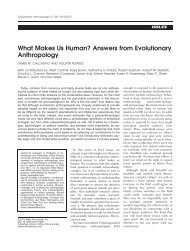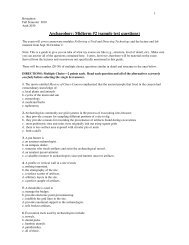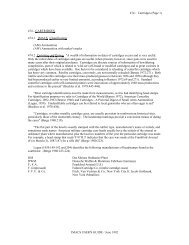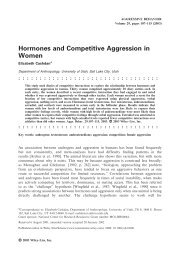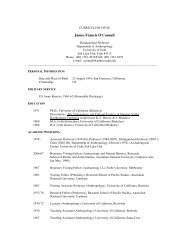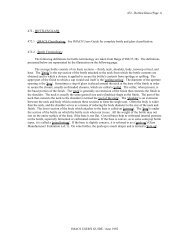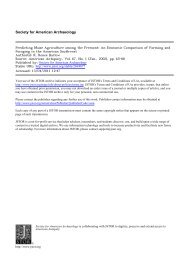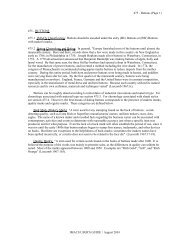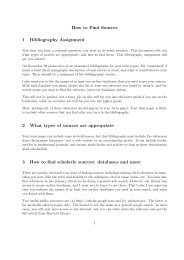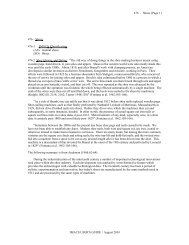Archaeology: Midterm #2 (sample test questions)
Archaeology: Midterm #2 (sample test questions)
Archaeology: Midterm #2 (sample test questions)
Create successful ePaper yourself
Turn your PDF publications into a flip-book with our unique Google optimized e-Paper software.
Broughton<br />
Fall Semester 2009<br />
Anth 2030<br />
1<br />
<strong>Archaeology</strong>: <strong>Midterm</strong> <strong>#2</strong> (<strong>sample</strong> <strong>test</strong> <strong>questions</strong>)<br />
The exam will cover the text readings, chapters 6-11, and the lecture material from Sept. 29 to Oct. 3.<br />
Note: This is a guide to give you an idea of what my exams are like (e.g., structure, level of detail, etc). Make sure<br />
you can answer all of the <strong>questions</strong> contained here. I stress, however, that there will be material on the exam derived<br />
from the lectures and readings not included in this guide.<br />
There will be a number (20-30) of multiple choice <strong>questions</strong> similar in detail and structure to the ones below.<br />
DIRECTIONS: Multiple Choice---2 points each. Read each question and all of the<br />
alternatives extremely carefully before selecting the single best answer.<br />
1. Which of the following is not among the limitations or problems with dendrochronology:<br />
a. it requires large specimens of wood to be preserved and recovered in archaeological contexts<br />
b. the set of rings obtained in a <strong>sample</strong> might not correspond to the year the tree was killed<br />
c. the cutting date might not correspond with the “target” archaeological event of interest<br />
d. the annular rings often do not preserve in otherwise well-preserved ancient wood<br />
2. When a piece of wood charcoal from an ancient hearth is radiocarbon dated, what is the actual event that is dated:<br />
a. the date the wood was burned<br />
b. the date the site was occupied<br />
c. the date the tree sprouted<br />
e. the date the tree died<br />
d. both a and b<br />
3. The movie entitled Mystery of Chaco Canyon emphasized that the ancient people that lived in the canyon had<br />
extraordinary knowledge of:<br />
a. local plants and animals<br />
b. cycles of the moon and sun<br />
c. entomology<br />
d. medicinal herbs<br />
4. The mistaken notion that the archaeological record is some perfectly crystallized and preserved reflection of past<br />
human behavior is known as:<br />
a. taphonomy<br />
b. formation processes<br />
c. N-transforms<br />
d. the Pompeii premise<br />
e. reverse utility curves<br />
5. The study of how prehistoric camps or residences were organized (e.g., where different activities took place)<br />
through the spatial arrangement of artifacts and features is known as:<br />
a. paleoenvironmental reconstruction<br />
b. site structure<br />
c. cultural ecology<br />
d. spatial utility analysis<br />
e. none of the above<br />
6. O’Connell’s ethnoarchaeological analysis of the Alyawara showed that:<br />
a. traditional assumptions made by archaeologists interested in site structure are incorrect<br />
b. big objects are more frequently removed from their original location of discard<br />
c. smaller objects are less likely to be removed from their original location of discard<br />
d. multiple, unrelated activities often occur at the same place<br />
e. all of the above<br />
7. The field concerned with determining the depositional origin of animal bones and natural processes that may have<br />
imparted patterning to bone assemblages is known as:
a. culture history<br />
b. cultural reconstruction<br />
c. taphonomy<br />
d. critical theory<br />
e. post-processual archaeology<br />
2<br />
8. The general class of dating methods that tells only whether one event is older or younger than another is known<br />
as:<br />
a. absolute dating<br />
b. radiocarbon dating<br />
c. relative dating<br />
d. relational dating<br />
e. cross dating<br />
9. The dating method that is based on the observation that the outer layer of certain rocks absorbs water and forms a<br />
measurable rim or rind over time is known as:<br />
a. obsidian hydration<br />
b. radiocarbon dating<br />
c. potassium argon dating<br />
d. frequency seriation<br />
e. dendrochronology<br />
10. The event that potassium-argon directly dates is:<br />
a. the death of an organism<br />
b. the cutting date for a tree<br />
c. the time since a fresh surface of obsidian was exposed to the elements<br />
d. the time when a volcanic rock was formed or solidified<br />
e. all of the above<br />
11. Evidence for cannibalism in the prehistoric American southwest was discussed in the text to highlight the issue<br />
of:<br />
a. whether Native American’s were “cannibals”, in general<br />
b. sex roles in prehistoric violence<br />
c. whether archaeologists are responsible for media reports<br />
d. relating ideology to the past<br />
e. who owns the past<br />
12. Archaeologists commonly use grid systems in the process of excavating sites because:<br />
a. they provide a means for sampling different portions of a site to dig<br />
b. they provide a means for recording the provenience of artifacts found during excavations<br />
c. most prehistoric sites and ruins were originally laid out using square grids<br />
d. there is less surface area exposed with circular pits or units<br />
e. both a and b<br />
13. Surveys that are designed to gather a representative <strong>sample</strong> of information on artifact and site distributions in a<br />
region are known as:<br />
a. non-systematic surveys<br />
b. gumshoe surveys<br />
c. systematic surveys<br />
d. superimposed surveys<br />
e. seriation surveys<br />
There will a number of terms, names, sites, for you to provide definitions for or otherwise indicate your familiarity<br />
with.<br />
II. Define or indicate your familiarity with the following terms, locations, or individuals:<br />
Processual archaeology<br />
Cultural materialism<br />
Behavioral ecology<br />
Post-processual archaeology<br />
Site structure<br />
Pompeii premise<br />
Ethnoarchaeology<br />
Faunalturbation
Deconstruction<br />
CRM-Cultural Resource Management<br />
NAGPRA<br />
Archaeological survey<br />
Systematic survey<br />
Remote sensing<br />
Plant or crop marks<br />
Arbitrary levels<br />
Temporal types or time markers<br />
Dendrochronology<br />
Radiocarbon dating<br />
Potassium-Argon Dating<br />
Obsidian hydration dating<br />
Biostratigraphy<br />
Formation processes<br />
Taphonomy<br />
NISP<br />
MNI<br />
Seasonality<br />
Ch’arki<br />
Coprolite<br />
Palynology<br />
Clovis<br />
Shanidar Cave<br />
Paleodemography<br />
Geoarchaeology<br />
Laetoli<br />
Hominids<br />
Old wood problem<br />
Homo erectus<br />
Heat treatment<br />
Systemic context<br />
Archaeological context<br />
Krotovina<br />
Reservoir effect<br />
Thermoluminescence dating<br />
Ishi<br />
Microwear<br />
Zooarchaeology<br />
Archaeofauna<br />
Comparative collection<br />
Phytoliths<br />
Wood rats<br />
Holocene<br />
Bioarchaeology<br />
Osteology<br />
Matrilocal residence<br />
Paleopathology<br />
Enamel hypoplasia<br />
Molecular archaeology<br />
3<br />
There will be one or two essay <strong>questions</strong> similar in detail and structure to the ones below. Study tip: Carefully<br />
preparing answers to these <strong>questions</strong> will not only help you prepare for this section of the exam, but will help for<br />
the multiple-choice and fill in the blank sections as well.<br />
DIRECTIONS-- Short Essay Questions:<br />
<strong>questions</strong>.<br />
Write a clear and concise answer to the following<br />
1. Describe how radiocarbon dating works and discuss three potential problems in applying this method to date<br />
archaeological materials.<br />
2. Discuss why it is crucial to understand the relationship between the event that is dated with dendrochronology<br />
and radiocarbon dating, and the target archaeological event of interest.<br />
3. Discuss in detail O’Connell’s ethnoarchaeological analysis of the Alyawara as discussed in class. What were the<br />
goals of his research, the methods he used, and the key results<br />
4. What is the “Reservoir effect” in the context of radiocarbon dating.<br />
5. Describe how the dating method of thermoluminescence works.<br />
6. Discuss two examples of “taphonomic” research discussed in the text.<br />
7. Discuss two examples of “experimental archaeology” discussed in the text.<br />
8. What is the difference between NISP and MNI as measures of animal abundances<br />
9. How did palynology shed light on determining whether Neandertals buried their dead<br />
10. What was learned from studying the coprolites from Hidden Cave<br />
11. Did the analysis of the Stillwater burials suggest that these people had lives that were “nasty, brutish and short”<br />
or those of an “affluent society”. Explain and defend your answer.<br />
12. In the text section entitled, The Zooarchaeology of a Peruvian Civilization, a study of animal bones revealed a<br />
shift through time in both species representation and skeletal part abundances. In particular, it was documented at the
Chavin de Huantar site that the abundance and importance of camelids increased through time at the same time that<br />
the leg bones of camelids became more abundant. What was the main hypothesis the analysts put forward to account<br />
for these trends<br />
13. Discuss in detail D.H. Thomas’ survey strategy in the Reese River Valley. Be sure to indicate the goals of the<br />
project, the methods he used to achieve them, and the primary conclusions.<br />
4


